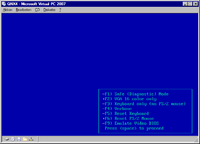Difference between revisions of "QNX"
From Computer History Wiki
(acquisition & version history) |
m (cleanup extra char) |
||
| Line 1: | Line 1: | ||
[[Image:Qnx4n000.png|thumb|right|200px|QNX 4.0 boot]] | [[Image:Qnx4n000.png|thumb|right|200px|QNX 4.0 boot]] | ||
| − | QNX was noted for being used as the [[Operating system|OS]] for the | + | QNX was noted for being used as the [[Operating system|OS]] for the Unisys ICON computer systems in Ontario High schools. It's a [[POSIX]] influenced [[Real-time system|RTOS]]. |
== History == | == History == | ||
Revision as of 11:02, 20 December 2023
QNX was noted for being used as the OS for the Unisys ICON computer systems in Ontario High schools. It's a POSIX influenced RTOS.
Contents
History
- 1982: Quantum Software - QUNIX for Intel 8088
- 1984: QUNIX was renamed to QNX
- 2004: QNX is acquired by Harman International Industries
- 2010: QNX is acquired by BlackBerry
QNX 4
Versions of QNX 4 were released between 1990 and 1997. QNX 4.24 was used as the origin of QNX/Neutrino. Future versions (except for 4.25) are based on the QNX/Neutrino fork.
Latest Version: 4.25
QNX 6
Versions of QNX 6 were released between 2001 and 2014, based on the QNX/Neutrino fork. Neutrino added support for MIPS, PowerPC, SH-4, and ARM CPU architectures.
This should be what RIM has purchased for use in the Playbook tablet.
Latest Version: 6.6
QNX 7
QNX 7 is the current version, initially released in 2017. Supported CPU architectures include 32-bit and 64-bit ARM, and 64-bit x86.
Latest Version: 7.1 (2020)
